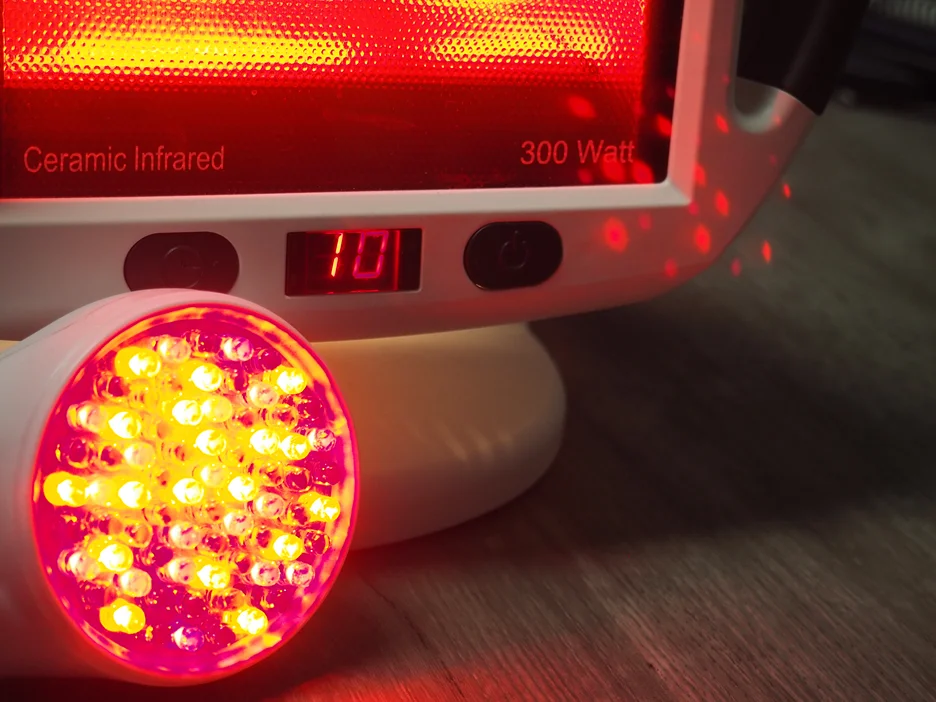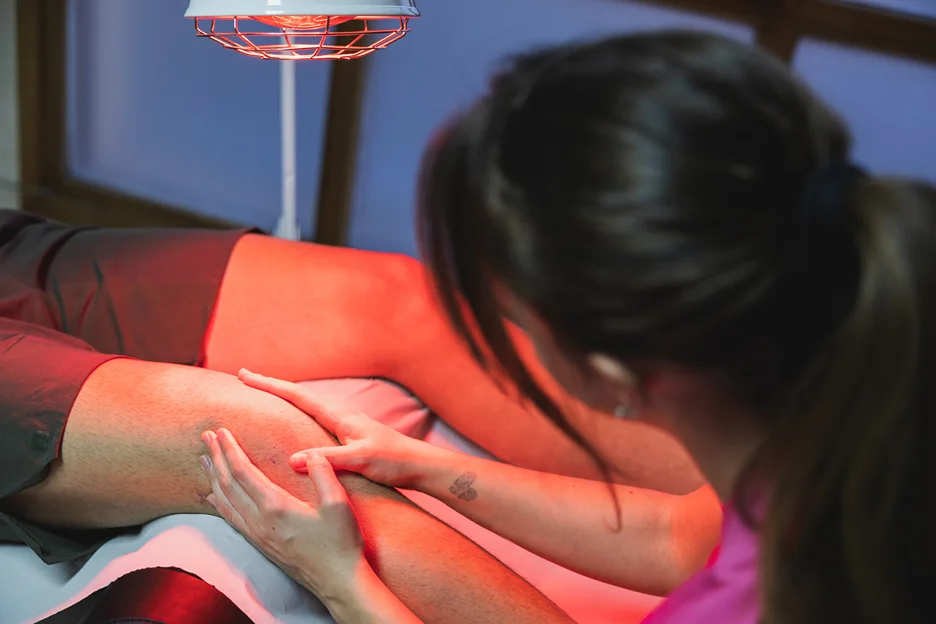Chronic sciatica can make life agonizing. Simple tasks like walking to the car or sleeping through the night become immense challenges.You might even start to lose hope that you’ll ever find lasting relief.
Our team here at Kaly understands how deeply frustrating sciatica can be.
While there are various treatment options available, from pain medications to steroid injections to surgery, many sciatica sufferers are seeking safer, drug-free alternatives.
One emerging treatment that has shown promise in reducing sciatic nerve pain is red light therapy.
But what exactly is red light therapy and can it really help alleviate your sciatica symptoms? Keep reading to learn all about this innovative, non-invasive treatment option.
What is Red Light Therapy and How Does it Work?

Red light therapy, also known as photobiomodulation or low-level laser therapy (LLLT), is a treatment that utilizes visible red and near-infrared light to stimulate healing, reduce inflammation and relieve pain in the body.
But how can simply shining light on your body provide pain relief? Here’s a closer look at the science behind this cutting-edge treatment:
Radiating Healing Wavelengths
Red light therapy devices emit light at certain wavelengths that can penetrate deep into skin and tissue. These wavelengths ranging from 600-900 nanometers are absorbed by cells and stimulate the mitochondria to produce more ATP (adenosine triphosphate) – the primary energy currency of cells. This flood of cellular energy activates a cascade of beneficial metabolic processes and stimulates healing.
Reducing Inflammation and Improving Circulation
By increasing cellular metabolism and energy production, red light therapy helps damaged cells repair themselves faster. It also reduces inflammatory cytokines and increases circulation by dilating blood vessels. This leads to reduced swelling and delivers more oxygen and nutrients to help heal damaged tissue.
The Potential for Nerve Regeneration
Pre-clinical studies on nerve cells have shown that near-infrared light can stimulate nerve regeneration and functional recovery. Though more clinical research is needed, this demonstrates the immense potential for red light therapy to heal conditions related to nerve damage, like sciatica.
Not All Light Therapy is Equal: Key Differences
Although red light therapy is often confused with similar modalities, it is quite distinct from infrared saunas, infrared heating pads, and LED therapy. Red light utilizes wavelengths that specifically stimulate the mitochondria and does not rely on heat. It is also different from laser therapy – lasers emit coherent, high intensity light unlike the gentle diffuse light in red light therapy devices.
Is Red Light Therapy Safe? Considerations Before Use
Red light therapy is considered very safe with minimal side effects as long as appropriate parameters are used. The wavelength, intensity, duration and frequency of treatment impacts results and safety. Near-infrared light is safer than higher frequency blue/violet light which can damage the eyes. Red light therapy is contraindicated for those with light-sensitive conditions or on photosensitizing medications. Discuss with your doctor before starting treatment if you have any concerns.
Can Red Light Therapy Help Relieve Your Sciatica Symptoms?

Now that you understand the underlying principles behind red light therapy, you’re probably wondering – can it really help with the debilitating nerve pain from sciatica? Sciatica can be complex, so let’s examine how this treatment can target the common causes and symptoms:
What’s Behind Your Sciatic Pain?
Sciatica refers to radiating leg pain, numbness, tingling and muscle weakness caused by compression or irritation of the sciatic nerve roots in the lower back. Some common causes include:
- Herniated or bulging discs putting pressure on the nerve roots
- Narrowing of spaces around the spine due to arthritis or bone spurs
- Inflammation or injury of the piriformis muscle or sacroiliac joint
- Spinal stenosis or narrowing of the spinal canal
Targeting Sciatica’s Underlying Causes
The anti-inflammatory and tissue healing effects of red light therapy may help address several of these underlying causes of sciatica by:
- Reducing spinal disc inflammation and promoting regrowth of disc tissue
- Easing muscle cramps, spasms and trigger points in the buttocks and legs
- Slowing arthritis development and easing related stiffness
- Restoring flexibility and promoting injury healing
Providing Possible Pain Relief
In addition to addressing underlying causes, red light therapy can help control painful sciatica symptoms by:
- Increasing circulation and oxygenation to reduce inflammation of compressed or irritated nerves
- Improving nerve signaling and function
- Relaxing muscles and easing spinal tension
- Reversing neuropathy from chronic nerve compression
- Stimulating natural pain relief by activating opioid receptors
Trying Red Light Therapy for Your Sciatica – Tips for Safe, Effective Treatment
Ready to give red light therapy a shot at easing your nagging sciatica flares once and for all? Here’s how to incorporate it into your pain management plan safely and effectively:
Choosing the Right Device
Not all red light therapy devices are equal. Look for an FDA-cleared device that uses the most clinically studied wavelengths of 600-950nm. More is not better – choose a device with intensities between 40-60 mW/cm2 to balance safety and effectiveness. Make sure it offers options to target the back directly. Consider ease of use and your budget.
Treatment Guidelines
Follow these guidelines to safely achieve optimal results:
- Duration: Start with 5-10 minutes daily, gradually increasing to 15-20 min sessions
- Distance: For concentrated nerve pain, position the device 2-4 inches away. For general use, 8-12 inches away.
- Angles: Target the lower back directly and rotate to cover the entire region
- Frequency: Daily use provides cumulative benefits, especially during severe flares
Proper Technique Maximizes Results
Applying the device correctly ensures the light penetrates deeply to reach compressed nerves:
- Lay face down and place the device directly over painful areas of the lower back.
- Position it as close as comfortable over the spine, slowly moving up and down.
- Widen pain relief by moving outward from spine to target surrounding muscles.
- Flip over and repeat along the front side of the hips and thighs.
- Rotate your trunk gently to spread light into the painful nerve paths.
Setting Realistic Expectations
It takes time for light therapy to genuinely impact chronic nerve pain. Expect gradual improvements over 4-12 weeks rather than instant relief. Track your pain levels and mobility to monitor progress. Consistency is key – stick with it even if flares continue initially before giving up.
Combine with Other Treatments
Though powerful alone, combining red light therapy with other modalities can provide even greater sciatica relief. Try these integrative pain management approaches:
- Heat/ice – Alternate these to alleviate nerve and muscle pain
- Targeted stretches – Gentle stretches to relieve nerve root tension
- Massage – Helps relax muscles squeezing nerves
- Pain medications – Red light therapy can enhance effectiveness and lower required dosages
- Surgery – Can accelerate pre and post-operative healing
Discuss integrating these therapies with your doctor or physical therapist for maximum, lasting pain relief results.
The Bottom Line

Chronic sciatica can feel hopeless, but advances like red light therapy empower you to take control of your pain.
Though more research is underway, anecdotal experiences and initial studies show its potential to reduce your symptoms and improve functionality. This non-invasive, drug-free option is worth exploring under your doctor’s supervision – it could finally provide the relief you’ve been waiting for.
Don’t let sciatica dictate your life. As your partner in tackling chronic back pain, Kaly encourages you to learn more and see if red light therapy is right for you. You have so much life ahead to live pain-free – we’re here to help you make that a reality.
